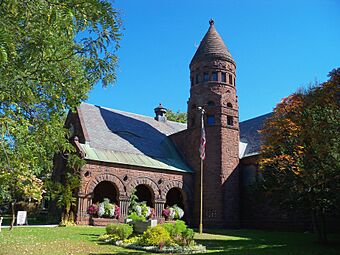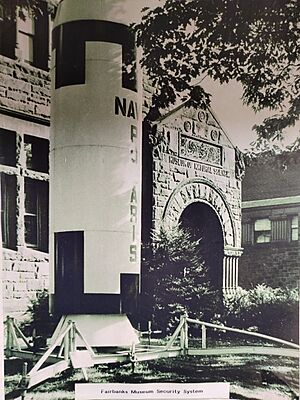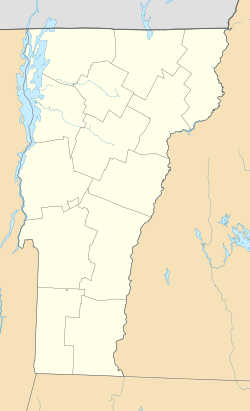Fairbanks Museum and Planetarium facts for kids
 |
|
|
Fairbanks Museum & Planetarium
|
|

Front of the main building
|
|
| Location | 1302 Main St., St. Johnsbury, Vermont |
|---|---|
| Area | 1 acre |
| Built | 1890 |
| Architect | Packard, Lambert |
| Architectural style | Romanesque |
| Website | www.fairbanksmuseum.org |
| NRHP reference No. | 07001344 |
| Added to NRHP | January 1, 2008 |
| Museum Director | Adam Kane (2014–) |
| Planetarium Director, Senior Meteorologist | Mark Breen (1981–) |
The Fairbanks Museum & Planetarium is a cool place in St. Johnsbury, Vermont. It's like three places in one! It has a natural science museum, a history museum, and a planetarium. A smart businessman named Franklin Fairbanks started it in 1890. The museum buildings are so important that they are on the U.S. National Register of Historic Places.
The Eye on the Sky Weather Center is a special station that forecasts the weather. It has been working there since 1893. Meteorologists, who are weather scientists, share their forecasts for Vermont, New Hampshire, and nearby areas. You can hear them on Vermont Public Radio and Magic 97.7. They also write daily weather forecasts for three newspapers: The Caledonian Record, Times Argus, and Rutland Herald.
The Lyman Spitzer Jr. Planetarium opened in 1960. It's inside the museum and shows amazing public astronomy shows. You can also take classes there to learn about space science. The planetarium also makes the Eye on the Night Sky radio show about astronomy. Plus, they write Night Owl articles about astronomy and spaceflight for online and print.
Contents
History of the Museum
The Fairbanks family had a long history in St. Johnsbury. Their company, Fairbanks Scales, had its main office and factories there since the 1820s. Franklin Fairbanks, who started the museum, used to be the president of this company. His father and uncle founded it.
Franklin Fairbanks already owned the land where the museum now stands. Workers got the land ready in 1889. Construction on the main building started on July 4, 1890. Franklin's wife, Frances Clapp Fairbanks, helped lay the first stone. The building was finished by spring 1891 and opened to visitors later that year. Lambert Packard designed the building. It looks like a Romanesque style, made with red sandstone and limestone.
The museum grew bigger in 1894. This was to hold all the new items. Before this, Franklin kept his collection in his own house, Undercliffe Mansion, since the 1870s. Many of the main things you see in the museum today came from Franklin's own collection. The museum was built just to show them off!

The planetarium and space gallery were added between 1959 and 1960. They replaced an older exhibit called the Colonial Room. The planetarium opened to the public in April 1961. It became the only public planetarium in Vermont. It has been updated many times but has always been open since then.
In 2017, the Shippee Family Eye Care Butterfly House was built. It's in the courtyard behind the museum's main area. It's an open building with a roof and benches. Visitors can walk among native butterflies and local flowers during the summer.
The Fairbanks Museum has been open almost all the time since it started. It usually closes for a short time each January for cleaning and to change exhibits. In March 2020, the museum closed because of the COVID-19 pandemic. It partly reopened from July to December 2020. The museum fully reopened in early March 2021, and the planetarium reopened in late May 2021 with some rules. Even when the museum was closed, the weather station and some learning programs kept going. They had online classes and science shows. They also gave updates about the pandemic to people in Vermont and New Hampshire.
From 2020 to 2023, big changes and building work happened. They expanded the eastern side of the main building. This project was called the "Tang Science Annex." It added more space for exhibits and made the museum easier to get around. The U.S. Department of Commerce helped pay for a lot of this work. They also did general repairs and kept the building in good shape.
What You Can See at the Museum Today
The museum has six main areas or categories. You can see these in its logo and the hexagon shapes around the museum. These areas are: Natural History, Geoscience, Ethnology, Engineering, Meteorology, and Astronomy. The museum has about 175,000 objects in total! They have special storage rooms for items not currently on display.
The museum's exhibits show many cool things. You can see natural specimens, a table with seasonal wildflowers, and the butterfly house. There's also a beehive you can watch. You'll find art made from insects and amazing taxidermy displays. These include animals like moose, bison, flamingos, bears, and birds. There are also exhibits about endangered and extinct species, dinosaurs, and fossils. You can learn about rocks and the Earth, different cultures from around the world, and old tools.
On the second floor, there's an exhibit about how ice crystals form in the air. It has photos by Snowflake Bentley, who was a friend of Franklin Fairbanks. You can also see old manufacturing tools and scales from the E & T Fairbanks Scales Company. Franklin's father and uncle, Erastus and Thaddeus Fairbanks, started that company. The museum often holds classes for local schools and tour groups. You can also listen to an audio tour as you walk around.
The Weather Center
The Fairbanks family started keeping weather records in St. Johnsbury back in the 1870s. These records were first at the Undercliffe mansion. Then, they moved to the Fairbanks Museum in 1891. Regular weather recordings at the same spot began in late 1893. Franklin Fairbanks himself liked to record the weather. This is partly why the museum continues to report on weather and atmospheric conditions. The weather tools are mostly behind the main building. They are also part of a weather recording exhibit. Some tools are on a frame on top of the museum roof.
The Northern New England Weather Center, also known as the Eye on the Sky Weather Center, started at the museum in November 1981. Meteorologists Steve Maleski and Mark Breen created it. They continued sending written weather reports to the NWS. But they also started forecasting weather for local radio and newspapers. They built studios for the meteorologists to broadcast. At first, the weather center was in the basement. People sometimes wondered how forecasters could see the sky without windows! In 2017, the weather center's studios moved to another building behind the museum.
The weather center creates the Eye on the Sky daily forecast. They also make Eye on the Night Sky, a weekly forecast for astronomy. Plus, they publish the Skywatch Almanac, a newsletter and online blog about weather and astronomy.
The Planetarium
The Lyman Spitzer Jr. Planetarium and Vinton Space Science Gallery is often called the "Spitzer Planetarium." It's at the top of a spiral staircase on the second floor, above the front entrance. It was built between 1959 and 1960. It first opened to the public in April 1961, when Fred Mold was the museum director. It's named after a famous scientist, Lyman Spitzer Jr.. He was a pioneer in modern astrophysics and how we observe space.
In the planetarium lobby, there's a space science gallery. You can see amazing photos of space from the Northern Skies Observatory in nearby Peacham, Vermont. There are also images from the Spitzer Space Telescope. You can even see an iron-nickel meteorite found in Patagonia. The gallery also has a Fairbanks Scale. It shows how much an object or person would weigh on the Moon or other planets in the Solar System.
The planetarium offers live shows and presentations, as well as movies. They cover many topics. You can learn about stargazing in your backyard, the history of astronomy, and constellations. They also teach about how constellations connect to different myths and cultures. Other topics include celestial navigation, artificial satellites, and space missions. You can learn about Lunar exploration, planetary science, the Sun (called heliophysics), and planets outside our solar system (called exoplanetary science). They also cover how things move in space (called astrodynamics) and the study of the universe (called cosmology). It is one of only two public planetariums in northern New England. The other is the McAuliffe-Shepard Discovery Center.
Planetarium Upgrades
The area where the planetarium is now used to have an exhibit about Vermont during the colonial period. When the planetarium first opened, it had simple folding chairs around a projector. In the early 1980s, these chairs were replaced with curved benches in semicircles.
In 2012, the planetarium got a big upgrade. They installed new digital equipment and software. This made it much more powerful and allowed them to show special 360° videos. However, the old analog equipment from the 1960s is still on display on the main floor. This includes a control panel and a special 12-sided shape with tiny holes that projected stars.
The planetarium was updated again between 2018 and 2019. They replaced the benches with modern theater seats. They also moved the curved projection screen forward. This allowed more people to sit comfortably. An elevator was also added to make it easier for everyone to reach the planetarium lobby from the main museum entrance.
Events and Outreach
The Fairbanks Museum & Planetarium set a Guinness World Record in 2018. They held the "largest astronomy lesson." A total of 1,580 people attended a 40-minute program across the street from the museum. The planetarium often works with the Vermont Astronomical Society and the Northern Skies Observatory. This observatory is in Peacham, Vermont. They host public outdoor astronomy events there and around the state.
In recent years, the Spitzer Planetarium also uses a smaller, blow-up dome. It's called a "portable planetarium." It uses the same projection software as the main planetarium. They use it for presentations at schools, libraries, and other indoor places nearby. Each spring, they have an astronomy camp. Kids learn about planets, stars, constellations, and space probe missions. They also get basic chemistry and physics lessons. This includes building and launching model rockets.
The museum has hosted many cool space events. They had special planetarium shows for the 2009 International Year of Astronomy. They also observed the 2012 Transit of Venus and the 2017 North American Solar Eclipse. In 2018, they set the world record for astronomy observation. From July 16 to 24, 2019, the museum had exhibits celebrating 50 years since Apollo 11. On July 20, they had a special event. It included a live replay of the mission and old documentaries from 1969. There was also model rocket building and launching, and spaceflight simulations. Planetarium shows focused on the Moon and past and future human lunar exploration. The museum even got real lunar regolith (moon dust) and rock samples from Apollo missions. NASA provided these for a short time to help teach the public about space.
When the museum was closed due to the COVID-19 pandemic, the planetarium hosted live online events. They answered questions from local people and students. These events included the 2020 Winter Solstice Jupiter-Saturn Conjunction. This showed telescope views and descriptions of the two planets and their moons. They also had live coverage of the Mars 2020 Perseverance rover landing. Fairbanks science communicators hosted this, showing live data from NASA JPL during the landing. They also celebrated Yuri's Night 2021. This marked 60 years since Vostok 1, 40 years since STS-1, and the first flight of the Mars 2020 Ingenuity helicopter. They also covered International Space Station moves and crew changes. In July 2021, the museum hosted an event with Dr. Jennifer Gruber. She is an engineer working on NASA's Artemis Program for the Moon. She gave updates about the program and answered questions.
For the 2024 North American Solar Eclipse, the museum expected an even bigger event than in 2017. This is because the path of totality passed right over Vermont. This offered a spectacular view of the total eclipse.
Awards and Recognition
The museum was added to the National Register of Historic Places in 2008. This means it's a very important historical site.
On August 10, 2018, the museum earned a world record. It was for the largest astronomy observation event. More than 1,500 people attended a live lesson about the night sky. There were also telescope demonstrations and other educational displays. Guinness World Records officially recognized this event. Vermont Public Radio and local news also covered it.
In 2019, the museum's weather station celebrated its 125th anniversary. The World Meteorological Organization, National Weather Service, and NOAA recognized it. It is the second oldest regular weather observation station in North America. Only the Blue Hill Meteorological Observatory is older. The Fairbanks station has been continuously recording weather since early 1894.
See also
- National Register of Historic Places listings in Caledonia County, Vermont
- List of science museums in the United States
- List of planetariums in the United States
- List of meteorology institutions





